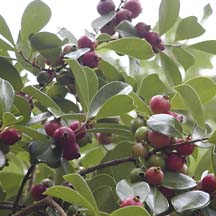
In the Garden![]()
Michael Miyashiro
HUI KU MAOLI OLA
Strawberry guavas a delicious but problematic.
Waiawi
(strawberry guava)LATIN NAME
Psidium cattleianum
I generally write about native Hawaiian or Polynesian-introduced plants, both of which are ecologically and/or culturally important. But this week, I will focus on another subject that is just as important when it comes to Hawaii's natural history, and that is invasive species.
Of the thousands of plants that have been introduced into Hawaii over the past 225 years since the arrival of Capt. James Cook, the strawberry guava has to be one of the worst invasive plants in Hawaii's mesic to wet forests. Hopefully, this column will shed new light on a topic that is often overlooked.
Description: There are three different forms of strawberry guava: one with small red fruit for which it's named, and two yellow-fruited forms, P. cattleianum variety littorale and P. cattleianum form lucidum. All three have glossy green leaves and smooth barks. The average height of this plant ranges between 6 and 20 feet, but variety littorale is a large tree that grows up to 40-plus feet and has a large canopy. From afar, monotipic stands (large areas dominated by a single type of plant) can be identified by their golden-green foliage and pinkish-brown tree trunks.
Distribution: Native to the Neotropics, strawberry guava is believed to have been introduced to Hawaii in 1825 by the British voyaging ship Blonde. Since then it has been widely cultivated as an ornamental and reforestation plant.
In the early 1900s this plant, along with many others now recognized as invasive species, were planted intentionally by forestry workers on mountain slopes denuded by grazing cattle. The idea was to plant fast-growing and easily naturalizing plants to control the mass amounts of soil being lost to erosion on the barren mountain sides. This meant weedy plants, not native ones.
Almost 100 years later, you can't walk up any ridge on this island without trekking through a strawberry guava forest. Today this plant is taking over the mesic and wet forest, between 150 and 1,300 meters, on all of the main islands except Niihau and Kahoolawe.
The problem is that in addition to the characteristics mentioned above, strawberry guava carries an arsenal of weapons that make it a successful invader. One such weapon is its will to live. Da buggah is hard to kill. You can't just cut 'em down -- they come right back. You gotta poison 'em, too.
The leaves of strawberry guava also possess allelopathic chemicals that are found within the leaf litter it spreads over the ground. The chemicals prevent other plant seeds, particularly native seeds, from germinating. Sometimes the leaf litter is so thick, it feels like you're bouncing on a sponge.
Speaking of sponges, strawberry guava also sucks up a lot of water, which depletes the watershed where they are found.
All of these reasons, plus the dense shade formed by their canopy, show how they shut out native plants from food and space.
Although strawberry guava is no longer being planted by man as a reforestation plant, other creatures help disperse this plant in other areas. Non-native animals like wild pigs and red-vented bulbuls eat the fruit and disperse the seeds to other areas.
What can you do to help? Go up into the mountains, gather all the strawberry guava fruit and make your own guava jam, jelly, juice, whatever you like. The wood is nice also, so rather than cutting down a koa or 'ohi'a tree to make something out of the wood, use strawberry guava.
Use dried strawberry guava wood in the imu, fireplace or smokehouse for smoked meat. If you have it in your garden, cut it down (don't forget to poison it and replace it with a native plant), or if you don't want to cut it, make sure you do something with the fruit before the birds eat them.
Eat the fruit when you go hiking. They taste great, and the seeds can be dispersed into the proper place -- the toilet.
Gardening Calendar


